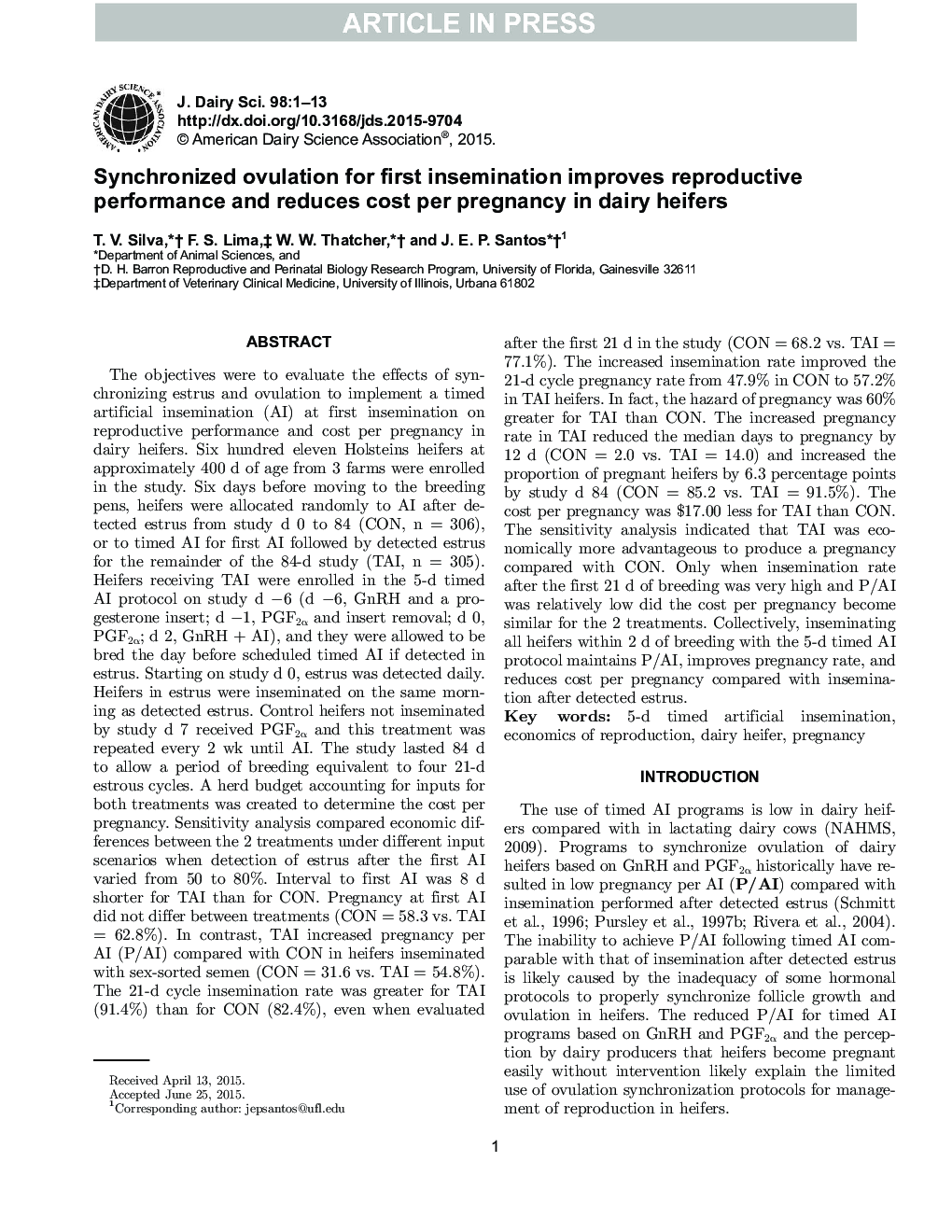| کد مقاله | کد نشریه | سال انتشار | مقاله انگلیسی | نسخه تمام متن |
|---|---|---|---|---|
| 10974542 | 1108026 | 2015 | 13 صفحه PDF | دانلود رایگان |
عنوان انگلیسی مقاله ISI
Synchronized ovulation for first insemination improves reproductive performance and reduces cost per pregnancy in dairy heifers
ترجمه فارسی عنوان
تخمک گذاری همزمان برای اولین تلقیح، عملکرد تولید مثل را بهبود می بخشد و هزینه های هر بارداری را در تلیسه های شیری کاهش می دهد
دانلود مقاله + سفارش ترجمه
دانلود مقاله ISI انگلیسی
رایگان برای ایرانیان
کلمات کلیدی
5 روزه تلقیح مصنوعی، اقتصاد تولید مثل، تلیسه لبنیات، بارداری،
موضوعات مرتبط
علوم زیستی و بیوفناوری
علوم کشاورزی و بیولوژیک
علوم دامی و جانورشناسی
چکیده انگلیسی
The objectives were to evaluate the effects of synchronizing estrus and ovulation to implement a timed artificial insemination (AI) at first insemination on reproductive performance and cost per pregnancy in dairy heifers. Six hundred eleven Holsteins heifers at approximately 400 d of age from 3 farms were enrolled in the study. Six days before moving to the breeding pens, heifers were allocated randomly to AI after detected estrus from study d 0 to 84 (CON, n = 306), or to timed AI for first AI followed by detected estrus for the remainder of the 84-d study (TAI, n = 305). Heifers receiving TAI were enrolled in the 5-d timed AI protocol on study d â6 (d â6, GnRH and a progesterone insert; d â1, PGF2α and insert removal; d 0, PGF2α; d 2, GnRH + AI), and they were allowed to be bred the day before scheduled timed AI if detected in estrus. Starting on study d 0, estrus was detected daily. Heifers in estrus were inseminated on the same morning as detected estrus. Control heifers not inseminated by study d 7 received PGF2α and this treatment was repeated every 2 wk until AI. The study lasted 84 d to allow a period of breeding equivalent to four 21-d estrous cycles. A herd budget accounting for inputs for both treatments was created to determine the cost per pregnancy. Sensitivity analysis compared economic differences between the 2 treatments under different input scenarios when detection of estrus after the first AI varied from 50 to 80%. Interval to first AI was 8 d shorter for TAI than for CON. Pregnancy at first AI did not differ between treatments (CON = 58.3 vs. TAI = 62.8%). In contrast, TAI increased pregnancy per AI (P/AI) compared with CON in heifers inseminated with sex-sorted semen (CON = 31.6 vs. TAI = 54.8%). The 21-d cycle insemination rate was greater for TAI (91.4%) than for CON (82.4%), even when evaluated after the first 21 d in the study (CON = 68.2 vs. TAI = 77.1%). The increased insemination rate improved the 21-d cycle pregnancy rate from 47.9% in CON to 57.2% in TAI heifers. In fact, the hazard of pregnancy was 60% greater for TAI than CON. The increased pregnancy rate in TAI reduced the median days to pregnancy by 12 d (CON = 2.0 vs. TAI = 14.0) and increased the proportion of pregnant heifers by 6.3 percentage points by study d 84 (CON = 85.2 vs. TAI = 91.5%). The cost per pregnancy was $17.00 less for TAI than CON. The sensitivity analysis indicated that TAI was economically more advantageous to produce a pregnancy compared with CON. Only when insemination rate after the first 21 d of breeding was very high and P/AI was relatively low did the cost per pregnancy become similar for the 2 treatments. Collectively, inseminating all heifers within 2 d of breeding with the 5-d timed AI protocol maintains P/AI, improves pregnancy rate, and reduces cost per pregnancy compared with insemination after detected estrus.
ناشر
Database: Elsevier - ScienceDirect (ساینس دایرکت)
Journal: Journal of Dairy Science - Volume 98, Issue 11, November 2015, Pages 7810-7822
Journal: Journal of Dairy Science - Volume 98, Issue 11, November 2015, Pages 7810-7822
نویسندگان
T.V. Silva, F.S. Lima, W.W. Thatcher, J.E.P. Santos,
